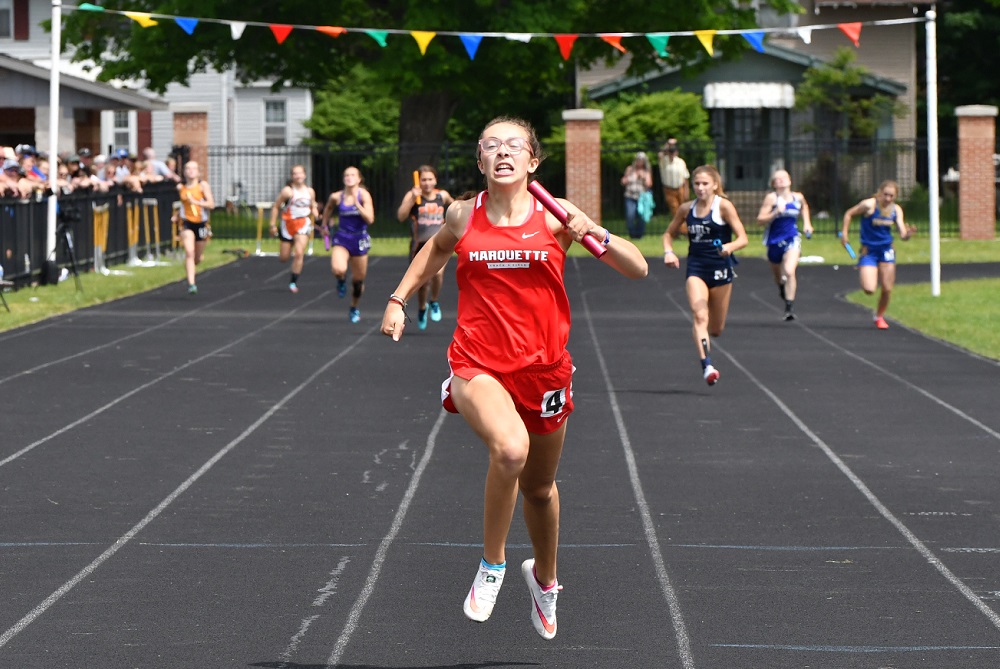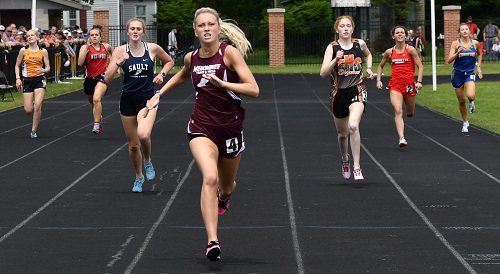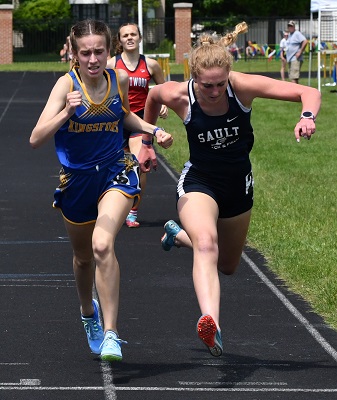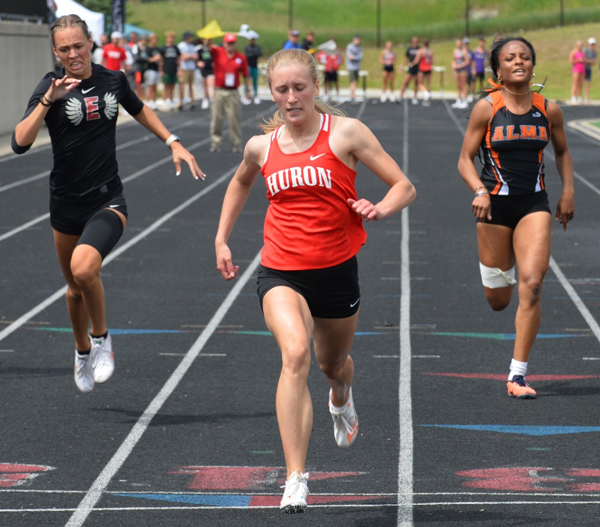
Truckey Paces Marquette's Run in UP Division 1
By
John Vrancic
Special for MHSAA.com
June 6, 2021
KINGSFORD — Sophomore Baux Truckey had a hand in four firsts Saturday at Kingsford, helping the Marquette girls retain their Upper Peninsula Division 1 track title with 120 points.
They were followed by Sault Ste. Marie with 94 points and Menominee with 71 on a hot and humid day at Flivver Field.
Truckey anchored the 400-meter relay which set the UPD1 Finals record at 50.11 seconds, topping the previous best (51.22) by Gladstone in 2007.
She also anchored the 800 relay (1:47.14), won the 100 (12.79) and edged teammate Julia Ott on a lean in the 200 (26.58).
 “Our handoffs went real well,” said Truckey. “Going 1-2 in the 200 was fun, but the heat was a factor. It was a relief to get done today. We have a lot of competition in practice, which I think is very helpful.”
“Our handoffs went real well,” said Truckey. “Going 1-2 in the 200 was fun, but the heat was a factor. It was a relief to get done today. We have a lot of competition in practice, which I think is very helpful.”
Ott won high jump at five feet and was clocked in 13.1 and 26.6 in the 100 and 200, respectively.
Kali McDonough captured pole vault (10-1), and Olivia Moffitt added a first in the 3,200 (12:00.03).
Sault senior Emily McLean set the UPD1 shot put record again, at 42-8½, topping her own mark (39-2) from two years ago.
The Central Michigan University recruit was crowned Straits Area Conference champion May 24 with a school-record toss of 46-8, then won at Tuesday’s Northern Michigan Meet of Champions at Gaylord (43-4).
“The heat was a factor,” she said. “It was kind of crazy. We were in the sun quite a while, although today’s weather forecast helped us mentally prepare for the heat. We knew what was coming.
 “I had kind of an off day in discus, but Joanne (Arbic, of Sault Ste. Marie) had a nice throw. I’m definitely excited for her and about going to Central.”
“I had kind of an off day in discus, but Joanne (Arbic, of Sault Ste. Marie) had a nice throw. I’m definitely excited for her and about going to Central.”
Houghton’s Lillian Williston won discus (116-10). Arbic placed second (114-7) and McLean was fourth (106-3).
Menominee senior Makenzie Wellner became a four-event winner, taking the 100 hurdles (15.7), 300s (46.7), long jump (16-8) and anchoring the winning 1,600 relay (4:11.6), which previously had set the school record at 4:09.01 in Marinette, Wis., on May 25.
“Our coach (Scott Melchoir) helped me with my approach and helped me jump a little further,” said Wellner, who plans to run track at Wayne State next season. “I was feeling good today. It was hard to find space under the bleachers today (due to the heat).”
Hayden Buck added a first in the 400 in a school-record 59.77 seconds.
In the 1,600, Houghton sophomore Ingrid Seagren ran second nearly the whole race before sneaking past Marquette’s Guinn Wuorinen for the victory. Seagren was clocked in 5:34.49 with Wuorinen at 5:34.59.
In another tight race, Kingsford’s Melanie Wenzel won the 800 (2:29.55), edging Sault senior Haleigh Knowles on a lean.
PHOTOS: (Top) Marquette's Baux Truckey anchors the 400 relay and crosses the finish line first Saturday at Kingsford. (Middle) Menominee's Hayden Buck crosses the finish line first in the 400. (Below) Kingsford's Melanie Wenzel, left, beats Sault Ste. Marie's Haleigh Knowles to the finish line. (Photos by Cara Kamps. Click to see more at RunMichigan.com.)

Multi-Sprint Champ Racing to Finish Huron Career Ahead of the Rest Again
By
Keith Dunlap
Special for MHSAA.com
May 25, 2023
NEW BOSTON – If there was one thing Elizabeth Anderson took pride in elementary school, it was simply showing that she could outrun everyone in sight.
 In fact, Anderson has an explanation for all the success she had in those playground races.
In fact, Anderson has an explanation for all the success she had in those playground races.
“Dominance when you are in elementary school,” Anderson quipped. “I don’t think I ever had a nickname. I just think everyone knew I was fast.”
Years later, pretty much everyone who follows track & field in the state of Michigan can attest to that.
A senior for New Boston Huron, Anderson has been faster than most other competitors in the state during her three-year high school career (with her freshman season in 2020 canceled due to COVID-19).
Last year, Anderson won titles at the Lower Peninsula Division 2 Finals in the 200-meter (25.07) and 400-meter (56.28) dashes, and was runner-up in the 100-meter dash (12.23).
Often, top sprinters focus on one or two of those three races. But Anderson is certainly a different breed of sprinter because she does all three.
In fact, she holds school records in all three of those events, and if all that weren’t enough, Anderson is a part of all three sprint relay teams.
“It is hard to give her events off,” said New Boston Huron head girls track coach Danielle Lobato.
Despite the different styles the 100, 200 and 400-meter dashes present, Anderson said there usually isn’t much adjusting when she goes from one of those races to another.
 The strategy is simply, “Let’s beat the other girls to the finish line.”
The strategy is simply, “Let’s beat the other girls to the finish line.”
“I don’t really go into each race changing up how I would run,” she said.
While enjoying and succeeding in all three races, Anderson said she actually does have a favorite among them.
“I would say the 400 is probably my favorite,” she said. “Even though it hurts, it’s satisfying to see how much you can get your time down in the 400 compared to any other race.”
Anderson said she started running track in sixth grade, but really got serious about it during the summer after her sophomore season, when she was invited to run for a local club.
Eventually, that led to her competing over the winter in indoor events.
She lived and breathed track so much that last fall, she decided to not run cross country so she could focus on a weightlifting regimen aimed at developing more leg strength.
“Once I started doing summer track, I realized I wanted to be doing this all the time,” she said.
Lobato said oftentimes in practice, Anderson is a de facto coach, given there is no better person she can think of for the younger runners on the team to learn from.
“I can’t always demonstrate these things I’m trying to teach,” she said. “You get to see it in real life (from Anderson), not in a YouTube video.”
After winning the 100, 200 and 400-meter dashes at her Regional meet last week, Anderson has her sights set on achieving the same trifecta of titles at next Saturday’s Finals in Grand Rapids.
Anderson has signed to run track at Michigan State, but has been plenty motivated to keep producing this spring in her final high school season.
“I’m really looking to defend my titles,” she said. “That is what is really motivating me to keep going. I want to keep in shape for the college season. I don’t want to lose any of the progress I have made. Ultimately, I just love running track.”
And since elementary school, Anderson has loved — and succeeded in — outrunning everyone else to the finish line.
“We knew we were getting something special,” Lobato said of when Anderson arrived in high school. “But you never expect this. All that she has accomplished is amazing.”
 Keith Dunlap has served in Detroit-area sports media for more than two decades, including as a sportswriter at the Oakland Press from 2001-16 primarily covering high school sports but also college and professional teams. His bylines also have appeared in USA Today, the Washington Post, the Detroit Free Press, the Houston Chronicle and the Boston Globe. He served as the administrator for the Oakland Activities Association’s website from 2017-2020. Contact him at [email protected] with story ideas for Oakland, Macomb and Wayne counties
Keith Dunlap has served in Detroit-area sports media for more than two decades, including as a sportswriter at the Oakland Press from 2001-16 primarily covering high school sports but also college and professional teams. His bylines also have appeared in USA Today, the Washington Post, the Detroit Free Press, the Houston Chronicle and the Boston Globe. He served as the administrator for the Oakland Activities Association’s website from 2017-2020. Contact him at [email protected] with story ideas for Oakland, Macomb and Wayne counties
PHOTOS (Top) New Boston Huron's Elizabeth Anderson clears the finish line during last season's LPD2 400 race. (Middle) Anderson, middle, outpaces the field to also win the 200. (Click for more from RunMichigan.com.)

